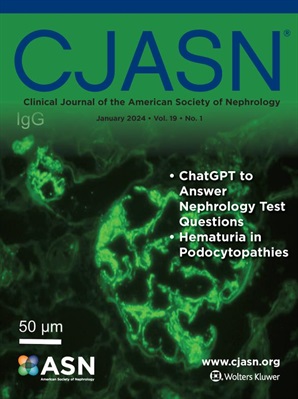Green, Sustainable Nephrology: State of the Art Needs for Education and Implementation.
IF 8.5
1区 医学
Q1 UROLOGY & NEPHROLOGY
Clinical Journal of the American Society of Nephrology
Pub Date : 2025-04-16
DOI:10.2215/cjn.0000000731
引用次数: 0
Abstract
Green nephrology, also often called sustainable nephrology, has become a field of interest in our discipline in recent years. While several reviews have been published, comparatively few original papers have appeared, witnessing interest but also lack of original data. Greater awareness of the impact nephrology has on the planet, including, but not limited to its carbon footprint, is needed to promote education and research on these issues. Increasing awareness entails increasing knowledge at various levels and it is for this reason that we are presenting this review focusing on educational activities that have been and could further be undertaken to spread knowledge of these topics. We start from a description of the various approaches to green nephrology: technical, mainly focused on dialysis, clinical, encompassing medical and non-medical treatments in all chronic kidney disease (CKD) phases, and comprehensive, embedding kidney care in the society. We further summarize what is known and the fundamental needs and problems we presently face in reducing dialysis carbon-print, optimizing the pathways of care, avoiding futility in clinical work and research, implementing lifestyle interventions and education. We further acknowledge the lack of data on lifecycle of items and procedures, including commonly used drugs, and identify research needs at various levels. We finally discuss some examples of educational programs on green nephrology that are already available at various levels, from medical schools (an educational game), to medical meetings (healthy eating, reduction of plastic and paper waste), and daily clinical practice, in which teaching passes also through examples (personalizing dialysis, adapting schedules to each patient). Finally, we identify some barriers educational approaches may offers ways to overcome, to promote effective, targeted interventions that will make us advance on the road to reduce nephrology's carbon footprint.绿色,可持续肾病学:教育和实施的艺术需求的状态。
绿色肾脏病学,也常被称为可持续肾脏病学,近年来已成为我们学科感兴趣的领域。虽然已经发表了一些评论,但相对较少的原创论文出现,见证了兴趣但也缺乏原始数据。需要提高对肾脏病学对地球的影响的认识,包括但不限于其碳足迹,以促进这些问题的教育和研究。提高认识就意味着在各个层次上增加知识,因此,我们提出这次审查的重点是已经开展和可以进一步开展的教育活动,以传播这些主题的知识。我们从绿色肾脏学的各种方法的描述开始:技术,主要集中在透析,临床,包括所有慢性肾脏疾病(CKD)阶段的医学和非医学治疗,以及全面的,嵌入社会的肾脏护理。我们进一步总结了我们目前在减少透析碳足迹、优化护理途径、避免临床工作和研究中的徒劳、实施生活方式干预和教育方面所知道的、基本需求和面临的问题。我们进一步认识到缺乏包括常用药物在内的项目和程序的生命周期数据,并确定了各个层面的研究需求。我们最后讨论了一些绿色肾脏病教育项目的例子,这些项目已经在各个层面上可用,从医学院(一个教育游戏),到医学会议(健康饮食,减少塑料和纸张浪费),以及日常临床实践,其中教学也通过实例(个性化透析,为每个病人调整时间表)。最后,我们确定了一些障碍,教育方法可能提供克服的方法,以促进有效的,有针对性的干预措施,这将使我们在减少肾病学碳足迹的道路上取得进展。
本文章由计算机程序翻译,如有差异,请以英文原文为准。
求助全文
约1分钟内获得全文
求助全文
来源期刊
CiteScore
12.20
自引率
3.10%
发文量
514
审稿时长
3-6 weeks
期刊介绍:
The Clinical Journal of the American Society of Nephrology strives to establish itself as the foremost authority in communicating and influencing advances in clinical nephrology by (1) swiftly and effectively disseminating pivotal developments in clinical and translational research in nephrology, encompassing innovations in research methods and care delivery; (2) providing context for these advances in relation to future research directions and patient care; and (3) becoming a key voice on issues with potential implications for the clinical practice of nephrology, particularly within the United States. Original manuscript topics cover a range of areas, including Acid/Base and Electrolyte Disorders, Acute Kidney Injury and ICU Nephrology, Chronic Kidney Disease, Clinical Nephrology, Cystic Kidney Disease, Diabetes and the Kidney, Genetics, Geriatric and Palliative Nephrology, Glomerular and Tubulointerstitial Diseases, Hypertension, Maintenance Dialysis, Mineral Metabolism, Nephrolithiasis, and Transplantation.

 求助内容:
求助内容: 应助结果提醒方式:
应助结果提醒方式:


